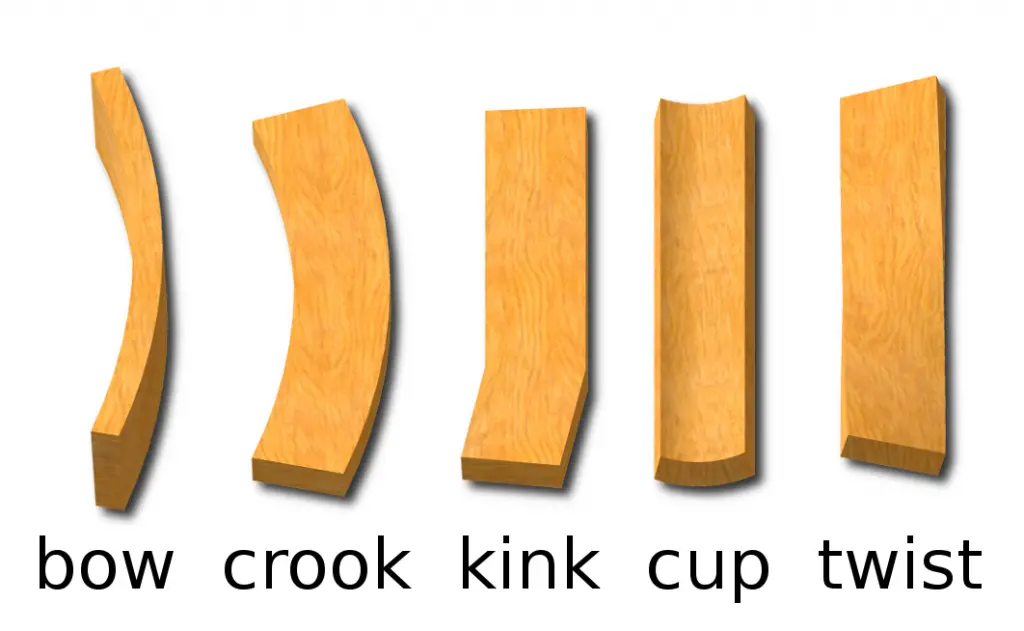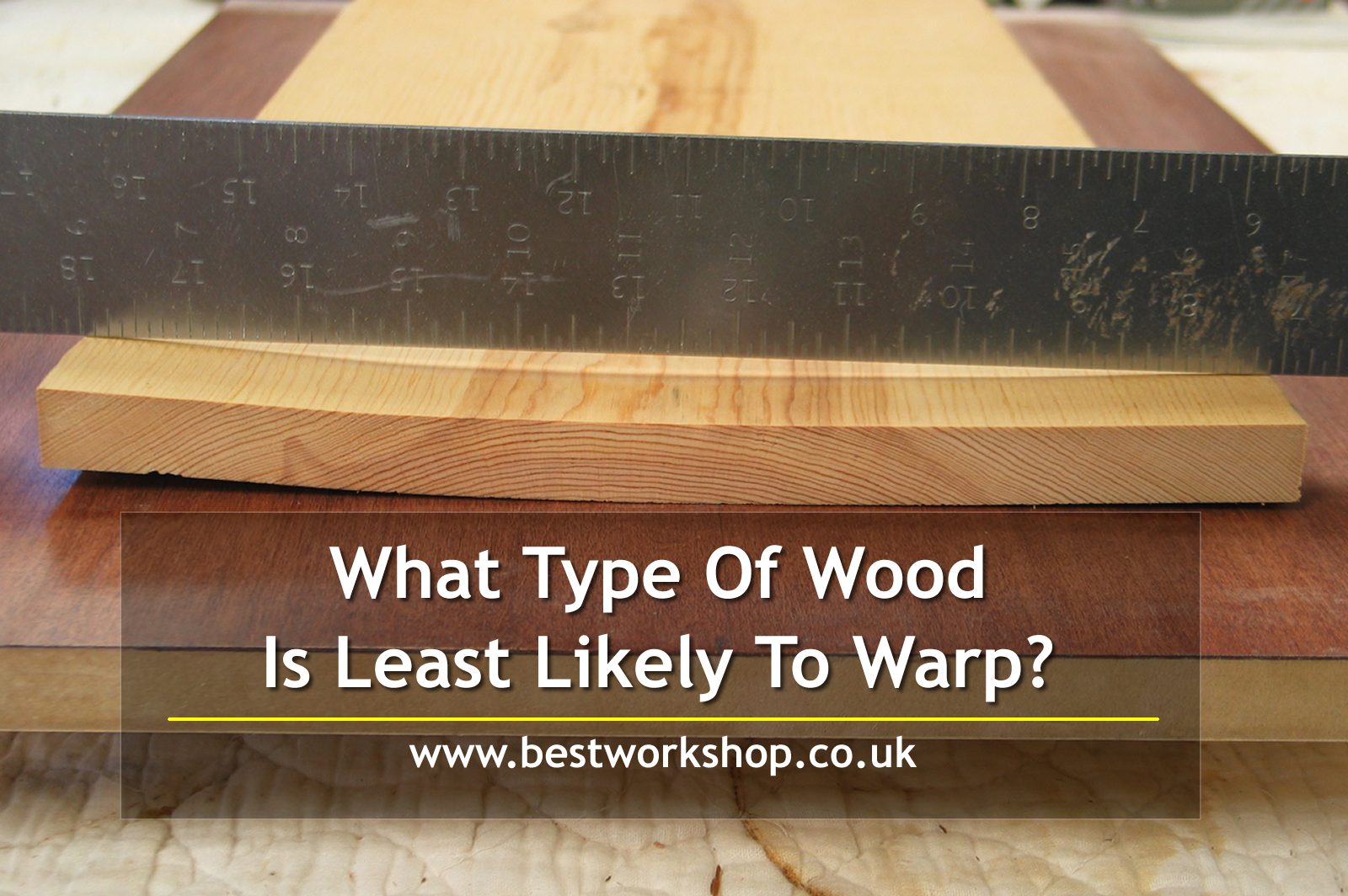Table of Contents
If wood is exposed to moisture, it will swell. When it dries out again, it will shrink and as this happens the wood can warp. This can be so frustrating so when it comes to choosing the right wood for your next project you may have been wondering what type of wood is least likely to warp.
There’s nothing more annoying than receiving a delivery of wood only to find that it’s warped before you’ve even had a chance to work on it. So, in this guide, we will introduce you to some of the woods that are least likely to warp and how you might prevent warping in the future.
What Causes Wood To Warp?
Warping is when wood deforms because of the moisture content within the board which can cause inconsistency and unevenness. Let’s say that one part of the timber dries more quickly than another; that part would shrink at a more rapid rate and alter the shape of the wood. While the board would have originally been flat, it now has a bend.
Wood warping can affect everything from newly cut boards through to finished products so it’s not something that you’ll ever be able to get away from although there are ways to avoid it to a degree which we will look at in more detail later on.
There are different types of wood warping including bowing, twisting and kinking. These are caused due to a relationship between the moisture content of the wood and the humidity within the air around it. If the moisture content is quite high, it will shrink so that it balances with the surrounding humidity. This is known as the equilibrium moisture content.
However, when the wood has a lower moisture content, it begins to swell as it draws in moisture from the air in order to reach that equilibrium.

Types Of Wood Least Likely To Warp
While all wood is susceptible to warping, there are some types of wood that seem to have fewer problems with this. Let’s take a look at the best options.
Redwood
Redwood is widely regarded as the best wood for resisting warping and shrinking. There are two reasons that this is the case. Primarily, redwood has a very straight grain pattern as well as a tannin-like compound inside that helps to prevent things like rot and moisture absorbing in.
However, redwood doesn’t come cheap, which is something to consider. But if you’re working on outdoor projects like decking or patio furniture then it’s well worth the investment. What’s more, it’s very easy to work.
Cedar
Cedar is an incredibly stable wood and would be an easy second choice after redwood. If you like a light coloured wood then cedar is a good option and on top of this, it’s extremely durable and strong. The reason for this durability is how dense cedar is which also plays a part in resisting water absorption.
Additionally, cedar has similar chemicals within it, like redwood, which will go a long way in preventing rot. But much like redwood, you can also expect to pay quite a lot for cedar.
Fir
When fir is seasoned, this process stops the wood from even being able to shrink. However, you will find that most fir is not kiln dried when it is sold so you’ll have to work with it as it is. Once installed, the wood will naturally shrink and expand but once it does, it will settle into a final position and not move again.
Cypress
Cypress is a beautiful light coloured wood with an exceptionally straight grain. This wood isn’t the most resistant to warping but it does a pretty good job of it. What’s more, cypress is a very resistant and durable type of wood that’s surprisingly easy to work with.
This wood is a great choice for outdoor projects like fences, door frames and window boxes. That said, we would always suggest applying a treatment for the best resistance.
Pine
Pine is incredibly common when it comes to woodworking, especially for furniture making. It’s a pale coloured wood with a very delightful aroma which is another of the reasons it is so popular. However, it’s also one of the best woods for resisting warping. While it is great for furniture, you’ll also find that it does well for things like decking and outdoor structures.

How Grain Pattern Affects Warping
There are several things that determine how resistant a piece of timber is to warping but one of the most prominent is the grain pattern. Keep in mind that wood cut from the centre of the tree will always have the greatest resistance to shrinking and warping.
Straight grained woods that are very closely packed are far less likely to suffer from warping problems. This is regardless of the type of wood since the close, straight grains make the wood denser and more resistant to moisture.
How To Prevent Wood Warping
Nobody wants warped wood and in many cases, it is unavoidable. That said, there are some things you can do to reduce the risk of problems as much as possible. One thing that is essential to keep in mind is that how you store your boards will impact their resistance to warping.
When stacking boards, you should place stickers between them to allow for better airflow. This will greatly decrease the chances of moisture getting stuck between the boards which will undoubtedly lead to warping. Moreover, it’s a good idea to only stack boards together that are of a similar thickness.
Wherever you are stacking boards, make sure that the foundation is flat and dry. If you want to avoid problems with cupping then you could place a series of heavy weights on the timber.
In some parts of the world, high humidity can create problems with warping. One of the best ways to eliminate serious problems is by wrapping the wood in water resistant material and stacking it in a place with excellent ventilation.
However, even before it comes to stacking the wood, you’ll need to make sure that it is properly prepared and this involves curing the timber. Most woods are kiln dried before being sold but even with this, the wood will still acclimate to the local humidity which could still cause warping issues.
But that shouldn’t put you off using kiln dried woods as there are lots of advantages to this including making the wood more resistant to insects and the process will set the sap.
When drying wood, it is essential to make sure that, once it begins to dry, you do not expose it to further moisture allowing it to reabsorb anything. Also, make sure that the drying process isn’t done too slowly as this could also cause warping and make sure that you don’t overdo it; wood that contains less than 20% moisture will be acceptable to use.
Conclusion
As a woodworker, you have probably had experiences with wood warping and this can be incredibly frustrating. Warping happens when moisture gets into the wood and dries unevenly. It’s not always something that can be helped although there are ways to avoid this including choosing wood that is less likely to warp.
This includes things like redwood, pine, fir, cedar and cypress. But you should also make sure that you always prepare and store your wood correctly for maximum resistance.


